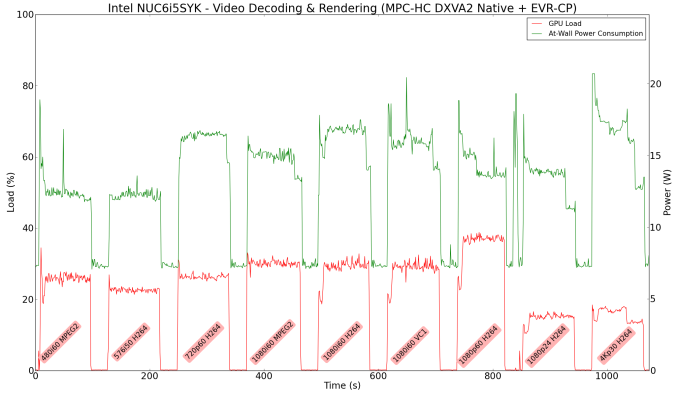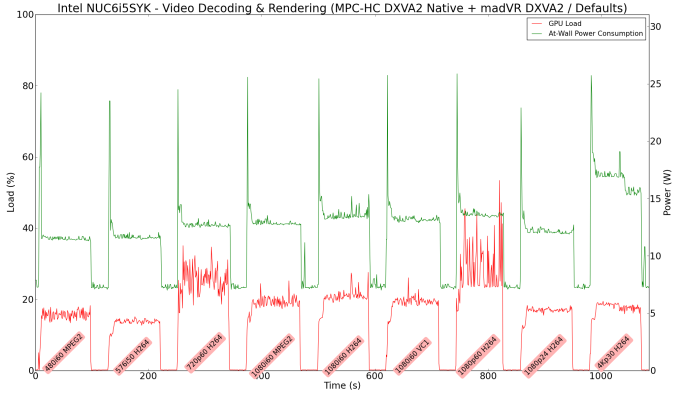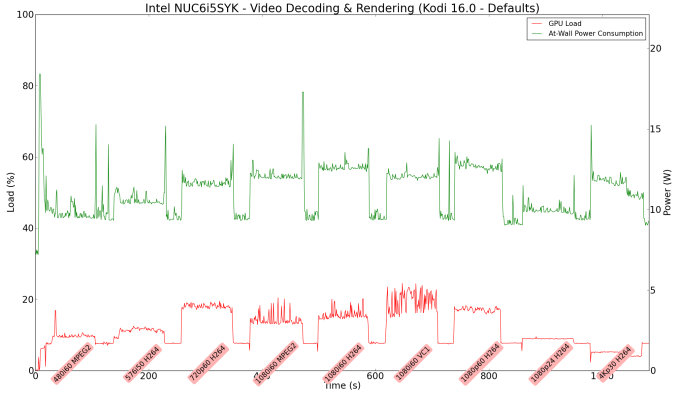The Intel NUC6i5SYK Skylake UCFF PC Review
by Ganesh T S on March 11, 2016 8:00 AM ESTHTPC Credentials
The thermal solution on the NUC6i5SYK is the same as what we have seen in the previous NUCs. Since the Core i5-6260U is a 15W TDP processor, the acoustics are pretty decent (when compared to the fans on the units with 28W TDP processors). Subjectively speaking, the unit is silent for most common HTPC use-cases. Only under heavy CPU / GPU loading (such as stressful madVR configurations) does the fan become audible. Like the previous NUCs, the NUC6i5SYK retains CIR support, enabling use of IR remotes in a home theater setting. The unit definitely makes a good HTPC for folks who don't want to pay the premium for a passively cooled system - however, we didn't find too many improvements over the previous NUCs for HTPC workloads. There is still no HDMI 2.0 / HDCP 2.2 / 4Kp60 HDMI support in the unit.
Refresh Rate Accuracy
Starting with Haswell, Intel, AMD and NVIDIA have been on par with respect to display refresh rate accuracy. The most important refresh rate for videophiles is obviously 23.976 Hz (the 23 Hz setting). As expected, the Intel NUC6i5SYK has no trouble with refreshing the display appropriately in this setting. In fact, the NUC6i5SYK has the most accurate display refresh rates of all the PCs that we have evaluated so far.
The gallery below presents some of the other refresh rates that we tested out. The first statistic in madVR's OSD indicates the display refresh rate.
Network Streaming Efficiency
Evaluation of OTT playback efficiency was done by playing back our standard YouTube test stream and five minutes from our standard Netflix test title. Using HTML5, the YouTube stream plays back a 1080p encoding. Since YouTube now defaults to HTML5 for video playback, we have stopped evaluating Adobe Flash acceleration. Note that only NVIDIA exposes GPU and VPU loads separately. Both Intel and AMD bundle the decoder load along with the GPU load. The following two graphs show the power consumption at the wall for playback of the HTML5 stream in Mozilla Firefox (v 44.0.2).

GPU load was around 24.27% for the YouTube HTML5 stream and barely measurable for the steady state 6 Mbps Netflix streaming case. Note that GPU usage reported by GPU-Z doesn't actually measure the load on the dedicated decoder engines in the GPU.
Netflix streaming evaluation was done using the Windows 10 Netflix app. Manual stream selection is available (Ctrl-Alt-Shift-S) and debug information / statistics can also be viewed (Ctrl-Alt-Shift-D). Statistics collected for the YouTube streaming experiment were also collected here.

Decoding and Rendering Benchmarks
In order to evaluate local file playback, we concentrate on EVR-CP, madVR and Kodi 16.0. We already know that EVR works quite well even with the Intel IGP for our test streams. Under madVR, we used the DXVA2 scaling logic wherever available, and left the rest at default (as it is well known that the stressful configurations don't work even on the Iris Pro-equipped processors). We used the DXVA2 native decoder in the LAV Filters bundled with MPC-HC v1.7.10
In our earlier reviews, we focused on presenting the GPU loading and power consumption at the wall in a table (with problematic streams in bold). Starting with the Broadwell NUC review, we decided to represent the GPU load and power consumption in a graph with dual Y-axes. Nine different test streams of 90 seconds each were played back with a gap of 30 seconds between each of them. The characteristics of each stream are annotated at the bottom of the graph. Note that the GPU usage is graphed in red and needs to be considered against the left axis, while the at-wall power consumption is graphed in green and needs to be considered against the right axis.
Frame drops are evident whenever the GPU load consistently stays above the 85 - 90% mark. The NUC6i5SYK has absolutely no trouble with any of our test streams. Kodi is the most power efficient of the lot, while madVR with DXVA scaling is actually quite power efficient and comparable to EVR-CP.
Moving on to the codec support, the Intel Iris Graphics 540 is a known quantity with respect to the scope of supported hardware accelerated codecs. DXVA Checker serves as a confirmation. Recent driver updates have added VP9 decode support, but, only for 8b encodes.





















95 Comments
View All Comments
Spunjji - Saturday, March 12, 2016 - link
I vote you leave the conversationdsumanik - Saturday, March 12, 2016 - link
vote denied.patrickjp93 - Friday, March 11, 2016 - link
Nope, with Skylake Iris = 64MB of eDRAM. Iris Pro = 128MB of eDRAM. You're thinking of Broadwell.damianrobertjones - Friday, March 11, 2016 - link
I have the NUC615SYH model in front of me now with the following:-HyperX Impact 16 GB 2400 MHz
-Samsung 250GB 850 EVO M.2
-Samsung 850 500GB evo 2.5"
All okay, updated to the latest firmward, installed Win10 fine BUT, as is often the case, the auto-driver facility from Intel fails to install a few drivers. You have to manually download and install.
Issues? Yes... The ethernet connection states that there's no internet connection despite being able to get onto the net. No other driver to try at this point in time so I'm using a USB nic.
All in all not bad.
blahsaysblah - Friday, March 11, 2016 - link
NUC5i7RYH- G.SKILL Ripjaws Series 16GB (2 x 8G) 204-Pin DDR3 SO-DIMM DDR3 1866 (PC3 14900)
- Micron M510 M.2 128GB SATA III Internal Solid State Drive (SSD)
- Intel X25M G2 80GB :)
Except for updating BIOS, do NOT install any drivers from Intel. You will get random crashes and issues. Only use what Windows Update gives. Has been rock solid once i did a clean install. Intel's Update tool was broken several months back too. Very surprising that it could not install drivers on a NUC.
From reading the benchmarks, the new 6i5 is a just because release. Unless you really want card reader, but you need a HUB to attack K,M, printer,.. anyway...
I wish they'd gone another direction.
It would be nicer if there was a plain office/developer and non HTPC version. Strip out all the radios, SDXC, HDMI,...
Just
- TPM,
- Lan(dual for VMs would be great),
- DP(1.3 chaining is fine, soon enough real 39"-44" 4k monitors will allow one monitor setups),
- USB (2 USB 2.0: KB,M; 4 USB 3.0: Webcam, printer, UPS, spare; 2 USB 3.0 front: spare, dedicated cellphone charger)
- combined headphone/mic
- 2x M.2 slots. Boot and data. Able to do backups internally. Also for VMs. Running Hyper-V VMs on mine is super smooth.
- the 2.5" drive option is really out of place/ancient. Without it, the bottom plate could be vented instead of sides.
- The removal of radios would allow the cooling solution to be almost doubled in size. I personally have the plastic top removed to allow better cooling.
A non HTPC, office/developer oriented NUC.
TheinsanegamerN - Friday, March 11, 2016 - link
2.5" isnt out of place until M.2 can actually catch up. M.2 is still limited to 512GB drives, and a 512GB m.2 cost more than a 1TB 2.5" SSD. And M.2 runs much hotter than 2.5"blahsaysblah - Friday, March 11, 2016 - link
Having the 5i7 in hand and using it for about 4 months now, the 2.5" is out of place in it. It interferes with cooling of everything on underside. It adds almost 3/4" height to the NUC where it was only 4.53" x 4.37" x 1.26" to begin with.Besides a vented bottom plate allowing the RAM, M.2(air flow is all they need) and other chips much better cooling its really the size issue.
I am running VMs on it with no issue. Taking a tiny NUC with you is much better than a laptop. For all the non-email jobs that require larger display and real keyboard. Again, saying a second non-HTPC line, the HTPC version can be used by folks just doing email.
The 5i7 was only offered in the larger format. I would not have gotten it given a choice. Hibernate, put in pocket. That 3/4" makes huge difference in usability.
Just a different point of view. For developers, engineers you need two internal drives and two M.2 drives are just fine.
kmmatney - Sunday, March 13, 2016 - link
As someone who uses a lot of VMs, I don't see how this is better than a laptop. Needing power, keyboard, mouse, and a monitor any time you need to use it doesn't sound convenient. I'm the opposite extreme, using a 17" laptop and 1.2TB of SSD space - but it's great for running software development VMs anywhere I need it, and I dock it to a 24" monitor in the office.bsly1314 - Monday, March 14, 2016 - link
+1. Furthermore, there seems no enough space to include power-loss protection in M.2 SSD. PLP is important for NUC which, unlike laptops, has no battery to act as backup. I live in third world where the electricity fails about once in a month...watzupken - Friday, March 11, 2016 - link
The real star of the Skylake is the GPU. CPU wise, its not much faster than Broadwell. And quite disappointed in areas where performance actually regress.